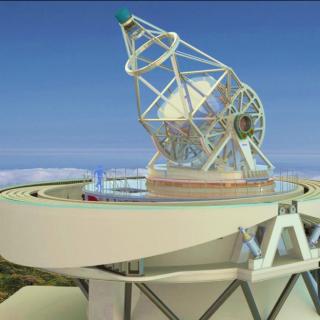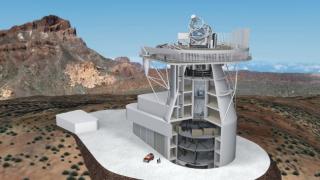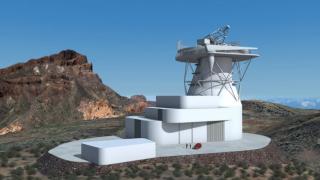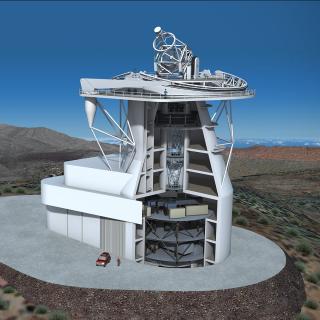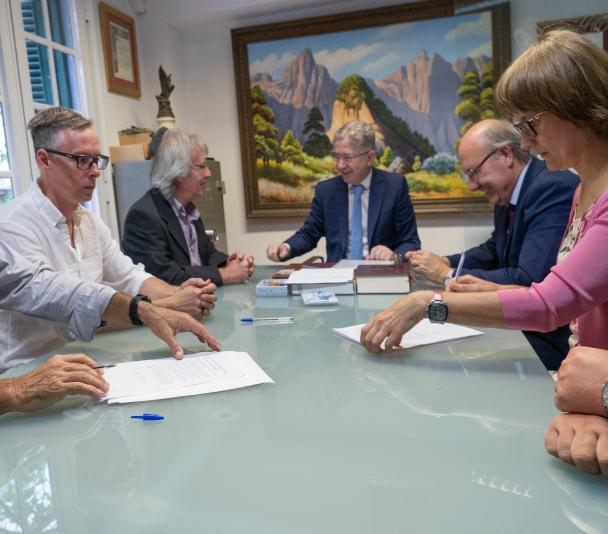9 institutions from 7 European countries today signed the documents for this organization, which will prepare the way towards the future construction of the European Solar Telescope (EST)
One of the main aims of the EST is to improve our understanding of the Sun by observing its magnetic fields in unprecedented detail
Representatives from 8 institutions in 7 European countries, among which are the Consejo Superior de Investigaciones Científicas (CSIC) and the Instituto de Astrofísica de Canarias (IAC) this morning in Santa Cruz de Tenerife, signed the founding documents of the Canary European Solar Telescope Foundation. This agreement gives a legal basis for the consortium of the project and paves the way towards the construction of the European Solar Telescope (EST) at the Roque de los Muchachos Observatory in the Canary island of La Palma.
The institutions responsible for creating this organization which will guide the project towards its construction phase belong to Germany, Slovakia, Spain, The Czech Republic, Sweden, Switzerland and the United Kingdom. Spain’s presence in the EST comprises the Instituto de Astrofísica de Canarias (IAC), which has overall coordination of the project, and the Instituto de Astrofísica de Andalucía of the CSIC (IAA-CSIC). The design of the instrument and part of its instrument compliment, the coordination of the international consortium and setting up the communications office of the EST are some of the contributions which these institutions have made to the project since its beginnings in 2008. Both have belonged to its scientific advisory committee since then.
The preliminary design phase of the telescope, partially funded by the Horizon 2020 programme of the European Commission, and the Canary Government, has recently concluded. Now the creation of the EST foundation marks a crucial milestone along the advancing path of the project towards its construction phase. One of its main objectives is to set up the European Consortium for infrastructure and Research (ERIC) with the EST, which will bring together the national ministries of the member countries. ERIC EST will be the legal entity given the tasks of supervising all aspects of the construction and use of this important scientific infrastructure.
By joining the EST foundation, the IAC and the IAA-CSIC acquire the power of decision over future scientific, technological and industrial aspects of the project.
An unprecedented technological challenge
The EST will become the largest solar telescope every constructed in Europe. With a primary mirror of 4.2 meters in diameter, forefront technology and its specialized instrument suite, EST will give astronomers a unique tool for observing the Sun. It will be built at the Roque de los Muchachos Observatory, on the Island of La Palma, recognized as one of the best sites in the world for astronomical observations.
The European Solar Telescope was included, on 2016, in the route map of the European Strategic Forum for Research Infrastructures (ESFRI), which gave it recognition as a strategic scientific infrastructure for Europe. One of its main objectives is to improve our understanding of the Sun by observing its magnetic fields in unprecedented detail.
The EST will dig out signals presently buried in the noise, and will reveal the existence of tiny magnetic structures on scales hitherto unexplored. Studying the magnetic and dynamic coupling of the solar atmosphere the telescope will give valuable knowledge about the mechanisms which underlie solar outbursts and coronal mass ejections. These phenomena determine “Space Weather” which has a strong influence on our highly technological society.
The optical configuration and the instrumentation of the EST are being designed with extreme care in order to capture the interactions between the different atmospheric layers of the Sun. The instruments will enable simultaneous observations at many wavelengths. This capability will give it unique efficiency compared with existing and planned solar telescopes, both ground based and in space.
The construction of the largest solar telescope in Europe is a technological challenge which, when the project is completed, will put Europe in a leading position for research in solar physics and in the development of the required scientific instrumentation.
EST Press release: https://est-east.eu/component/content/article/14-english/news/1249-creation-est-canarian-foundation?Itemid=659
IAA-CSIC Press release: https://www.iaa.csic.es/noticias/el-iaa-csic-y-el-iac-participan-en-creacion-fundacion-canaria-telescopio-solar-europeo
CSIC Press release: https://www.csic.es/es/actualidad-del-csic/el-csic-y-el-iac-participan-en-la-creacion-de-la-fundacion-canaria-telescopio
